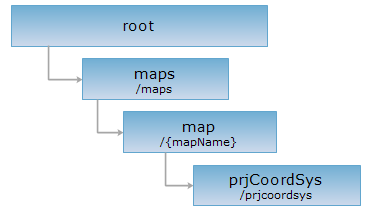
<map_uri>/prjCoordSys[.<format>]
ERROR: Variable (map_link) is undefined.
As a child resource of the map resource, prjCoordSys represents the information about the coordinate system of a map.
Supported to return the map coordinate system information with the common format of WKT(Well-known Text)Supported methods
Supported output formats: rjson, json, html, xml, WKT.

Implement the HTTP request on the following URI and return the response in rjson format. In the URI below, supermapiserver is the name of the server, and WorldMap is the map name ({mapName}).
http://supermapiserver:8090/iserver/services/map-world/rest/maps/WorldMap/prjCoordSys.rjson
Gets information about the coordinate system of a map.
| Field | Type | Definition |
| _cache | boolean | [Optional parameters] Whether to use cache, the default is True. False means close all the caches. |
Parameters returned by implementing the GET request on the prjCoordSys resource:
| Name | Type | Description |
| type | PrjCoordSysType | The type of coordinate reference system. For example, PCS_EARTH_LONGITUDE_LATITUDE is a geographic coordinate system. |
| name | java.lang.String | The name of coordinate reference system. |
| coordSystem.unit | Unit | The unit of the coordinate system. |
| coordSystem.name | java.lang.String | The name of the coordinate reference system, such as GCS_WGS_1984. |
| coordSystem.spatialRefType | SpatialRefType | The type of the coordinate reference system. The type can be planar, geography, or projected. |
| coordSystem.type | CoordSysType | The specific type of the coordinate system. For example, GCS_WGS_1984. |
| datum.name | java.lang.String | The name of the datum. |
| datum.type | DatumType | The type of the datum. For example, DATUM_WGS_1984 means the datum is WGS 1984. |
| spheroid.axis | double | The semi-major radius of the spheroid. |
| spheroid.flatten | double | The flattening of the spheroid. |
| spheroid.name | java.lang.String | The name of the spheroid, such as WGS_1984. |
| spheroid.type | SpheroidType | The type of the spheroid. For example, SPHEROID_WGS_1984 means the spheroid is WGS 1984. |
| primeMeridian.longitudeValue | double | The prime meridian, in decimal degree. |
| primeMeridian.name | java.lang.String | The name of the prime meridian. |
| primeMeridian.type | PrimeMeridianType | The type of the prime meridian. For example, PRIMEMERIDIAN_GREENWICH means that the prime meridian is the Greenwich Meridian, i.e., the meridian at 0? |
Implement a GET request on the prjCoordSys resource with http://supermapiserver:8090/iserver/services/map-world/rest/maps/WorldMap/prjCoordSys.rjson, the returned response in rjson format would be as follows:
{
"coordSystem": {
"datum": {
"name": "D_WGS_1984",
"spheroid": {
"axis": 6378137,
"flatten": 0.0033528107,
"name": "WGS_1984",
"type": "SPHEROID_WGS_1984"
},
"type": "DATUM_WGS_1984"
},
"name": "GCS_WGS_1984",
"primeMeridian": {
"longitudeValue": 0,
"name": "Greenwich",
"type": "PRIMEMERIDIAN_GREENWICH"
},
"spatialRefType": "SPATIALREF_EARTH_LONGITUDE_LATITUDE",
"type": "GCS_WGS_1984",
"unit": "DEGREE"
},
"coordUnit": "DEGREE",
"distanceUnit": "METER",
"epsgCode": 1,
"name": "Geographic Coordinate System---GCS_WGS_1984",
"projection": null,
"projectionParam": null,
"type": "PCS_EARTH_LONGITUDE_LATITUDE"
}
Execute GET request for the prjCoordSys resource: http://supermapiserver:8090/iserver/services/map-world/rest/maps/WorldMap/prjCoordSys.wkt, and return the binary file in the WKT format. Save and open it, the contents are as follows:
GEOGCS["GCS_WGS_1984",DATUM["D_WGS_1984",SPHEROID["WGS_1984",6378137.0,0.0033528107]],PRIMEM["Greenwich",0.0],UNIT["DEGREE",0.017453292519943295],AUTHORITY["EPSG","4326"]]
Asks for the response identical to the one that would correspond to a GET request, but without the response body. This is useful for retrieving meta-information written in response headers, without having to transport the entire content. The meta-information includes the media-type, content-encoding, transfer-encoding, content-length, etc.
The HEAD request helps check the existence of the prjCoordSys resource and whether it can be accessed by the client. By implementing the HEAD request on the URI, with .<format> appended to the end, we can quickly get to know whether the prjCoordSys resource supports the representation in <format> or not.